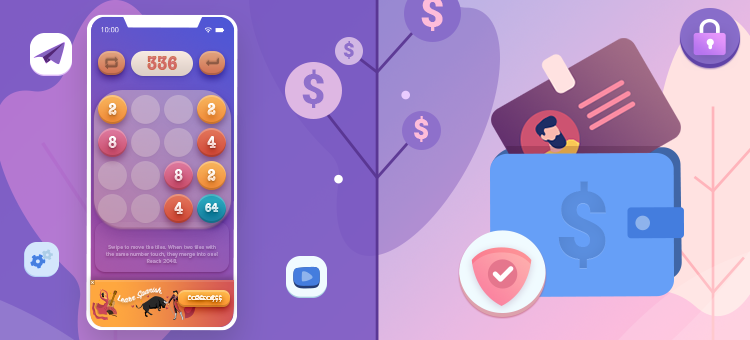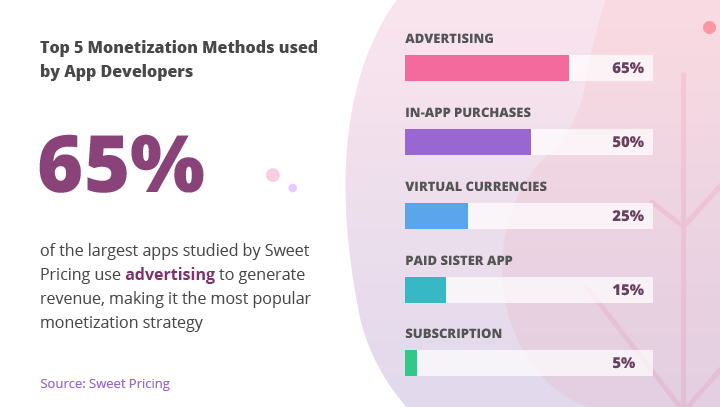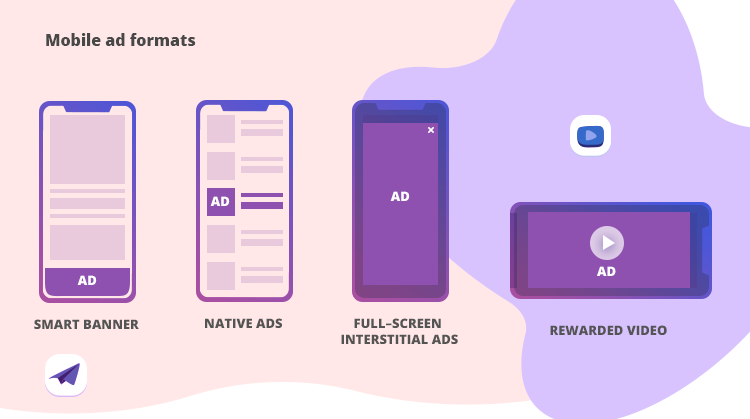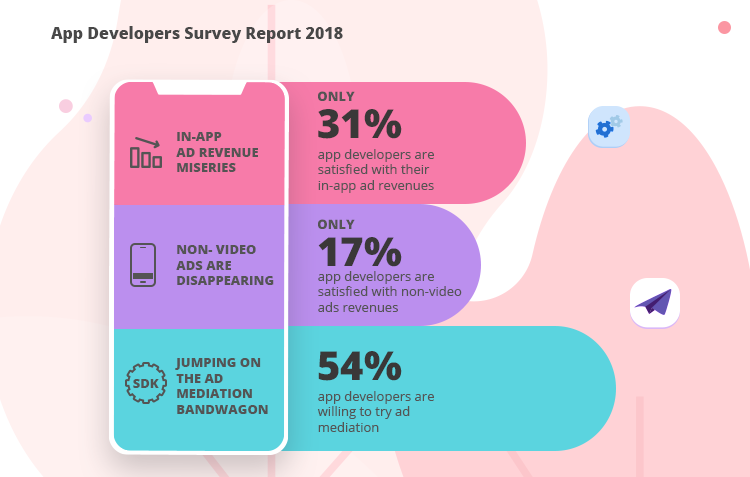Monetization of user data vs Advertising in the application: pros and cons
In 2018, the market for mobile applications continued to grow, not only thanks to users who do not release the phone from the hands of 24/7, but also thanks to advertisers who have picked up on advertising inside applications. Since the audience engagement here is incomparably higher, the cost of advertising in applications has increased, which has led to the evolution of the monetization of free applications.

In this article, we will compare two ways to monetize: advertising within applications and monetizing data. And if the first method is already firmly entrenched in the monetization strategies of millions of developers, then the second has been actively talked about only recently.
We will consider the main pros and cons, dispel popular myths and help determine the most successful solution for monetizing your application.
Advertising monetization is the most obvious and win-win way to monetize applications. According to 2017 statistics, more than 65% of developers prefer advertising to other monetization models .

Advertising in applications involves placing, managing and optimizing advertising campaigns in the app. This is a great tool to increase profits by selling ad space to brands, ad networks, and DSP .

Statistics happy: App Annie predicted, the marketing budget that advertisers invest in mobile apps will reach $ 206 million by 2021. For comparison, in 2016, the advertising budget for advertising in applications was only $ 72 million. This means that in the near future, the volume of the mobile advertising market will grow, plugging into desktop belt ads and even TV.
Mobile advertising formats are wildly popular: they spend 51% of the world's total digital budget, and this percentage will only grow.
The example of Pinterest is very revealing, which in 2018 broke the record of profitability , earning over 9 months more than $ 500 million (+ 43.8% compared with 2017).
Of course, this is an infrequent case. But it shows that advertising budgets will be enough for everyone and the income growth doubled is not a myth at all.
A study of the Chocolate advertising mediation platform confirmed that 54% of application developers view advertising mediation as a source of increased profits from an application (although the study is subjective, but I think that this particular figure is not far from the truth).

Suppose you just google some information about advertising mediation and are seriously considering the option of integrating with some kind of platform. As in any model, there are positive and negative sides to advertising mediation, which you should be aware of before integration.
Pros:
Minuses:
To succeed in the monetization of the application, you need to invest time and effort in the constant optimization of advertising. But developers' attention is usually focused on completing features, which is why they most often pass on management of advertising mediation and optimization of advertising campaigns to application monetization platforms.
But if you decide to do everything yourself, here is a small checklist that will help you in preparing for monetization.
Information still solves everything, and user information in troubled times GDPR is doubly valuable. Impersonal user data is an invaluable asset for marketers, research institutes and product companies.
Increased interest in user data has stimulated the growth of monetization of data in mobile applications. For developers, this is an extra income that requires minimal effort.
What data is transmitted to third parties and is it safe? Yes, safe. Confidential and any personalized information is not transferred to third parties, which means all users remain anonymous.
Data that is collected about users include:
Monetizing data is easier than running an ad in an application — just install one SDK.
Important! Play by the rules: before collecting user data, ask if he is not against providing non-personal data. And if against, exclude it from the user base for monetization.
Pros:
Minuses:
After the GDPR, European companies and users are very wary of collecting personal data. Recently, the TheGuardianApp team found out that some super-popular applications secretly transmitted user location data to third parties. In particular, the data on the battery level, the exact location of the GPS and other personal data were also transmitted.
What else is considered personal data?

The same TheGuardianApp provided a list of companies that collect too many personal data of users, and we hope that your application is not among them.
In general, these are two equally excellent tools that, if used properly, will be able to double the profits from the monetization of applications. If you do not yet understand where to start, look at what methods of monetization use competing applications in Google Play, the App Store and other app stores.
Data monetization and advertising in the application can be connected at the same time - their SDK perfectly interact with each other. Remember that the key to profit is not a bunch of advertising, but the users involved. Without respect for users and the transparency of the application, of course, will live - but not for long.
Have questions about data monetization or other application monetization models?
Register for a free webinar for Android developers on October 23, ask questions and start earning with new chips monetizing applications to mass HYIP.
Important! The webinar will be in English.

In this article, we will compare two ways to monetize: advertising within applications and monetizing data. And if the first method is already firmly entrenched in the monetization strategies of millions of developers, then the second has been actively talked about only recently.
We will consider the main pros and cons, dispel popular myths and help determine the most successful solution for monetizing your application.
In-app advertising: the main factor of monetization of the application
Advertising monetization is the most obvious and win-win way to monetize applications. According to 2017 statistics, more than 65% of developers prefer advertising to other monetization models .

Advertising in applications involves placing, managing and optimizing advertising campaigns in the app. This is a great tool to increase profits by selling ad space to brands, ad networks, and DSP .

Statistics happy: App Annie predicted, the marketing budget that advertisers invest in mobile apps will reach $ 206 million by 2021. For comparison, in 2016, the advertising budget for advertising in applications was only $ 72 million. This means that in the near future, the volume of the mobile advertising market will grow, plugging into desktop belt ads and even TV.
Mobile advertising formats are wildly popular: they spend 51% of the world's total digital budget, and this percentage will only grow.
The example of Pinterest is very revealing, which in 2018 broke the record of profitability , earning over 9 months more than $ 500 million (+ 43.8% compared with 2017).
Of course, this is an infrequent case. But it shows that advertising budgets will be enough for everyone and the income growth doubled is not a myth at all.
A study of the Chocolate advertising mediation platform confirmed that 54% of application developers view advertising mediation as a source of increased profits from an application (although the study is subjective, but I think that this particular figure is not far from the truth).

Suppose you just google some information about advertising mediation and are seriously considering the option of integrating with some kind of platform. As in any model, there are positive and negative sides to advertising mediation, which you should be aware of before integration.
Pros:
- It holds several ad networks in one SDK: there is no need to separately agree on integration with each grid.
- You can show mobile ads even with a small DAU.
- No independent settings of the waterfall model: the monetization team will do it for you.
- Advertising revenue can be maximized by adding high-paying advertising formats (for example, rewarded video and native ads).
- Regular payments from all demand partners in one payment.
- Live users without bots in a small application are much more valuable than questionable millionaire applications, so the chance to find a suitable platform to monetize your traffic is quite high.
Minuses:
- After integrating advertising into an application, you will have to optimize it daily (if you are not working with a company that optimizes advertising for you: Epom Apps, Ironsource, Adincube, etc.)
- You need to dive deep into the features of advertising mediation. Usually, one demand partner is not enough to provide you with a 100% fill rate at a high price. You have to test, cooperate with different advertising partners and analyze their effectiveness in order to find the right balance.
- Users are annoyed by advertising out of place, intrusive pop-ups and interstitial. According to statistics, 14% of users remove the application due to intrusive advertising.
To succeed in the monetization of the application, you need to invest time and effort in the constant optimization of advertising. But developers' attention is usually focused on completing features, which is why they most often pass on management of advertising mediation and optimization of advertising campaigns to application monetization platforms.
But if you decide to do everything yourself, here is a small checklist that will help you in preparing for monetization.
Data monetization: what is good, what is bad
Information still solves everything, and user information in troubled times GDPR is doubly valuable. Impersonal user data is an invaluable asset for marketers, research institutes and product companies.
Increased interest in user data has stimulated the growth of monetization of data in mobile applications. For developers, this is an extra income that requires minimal effort.
What data is transmitted to third parties and is it safe? Yes, safe. Confidential and any personalized information is not transferred to third parties, which means all users remain anonymous.
Data that is collected about users include:
- Device type
- Device version
- Screen size
- Mobile operator
- Connection type
- CPU number;
- RAM, ROM;
- A country
- IP
Monetizing data is easier than running an ad in an application — just install one SDK.
Important! Play by the rules: before collecting user data, ask if he is not against providing non-personal data. And if against, exclude it from the user base for monetization.
Pros:
- Safe and scalable source of income (does not violate the GDPR and Google Policy)
- In addition to a one-time installation of the SDK, you do not need to do anything extra.
- Data collection occurs in the background and does not affect the UX.
- Does not require monitoring and additional attention.
- You receive monthly income from each user who agreed to the processing of their data. The more DAU / MAU in the application, the higher the payments.
- Data monetization does not affect the existing SDK and monetization model.
Minuses:
- Data collection is now a very controversial topic - although in a global sense, users do not care whether their data is collected or not, they need to be treated carefully.
- Before installing the SDK, check all the parameters that you pass to data buyers.
- Monetizing data becomes profitable with a DAU of 50,000, as data buyers are more willing to consider large amounts of user data. If there are 300 users in your application, 10 of whom agreed to transfer their data - you will not see the sky in diamonds :)
After the GDPR, European companies and users are very wary of collecting personal data. Recently, the TheGuardianApp team found out that some super-popular applications secretly transmitted user location data to third parties. In particular, the data on the battery level, the exact location of the GPS and other personal data were also transmitted.
What else is considered personal data?

The same TheGuardianApp provided a list of companies that collect too many personal data of users, and we hope that your application is not among them.
What is better: data monetization or good old advertising?
In general, these are two equally excellent tools that, if used properly, will be able to double the profits from the monetization of applications. If you do not yet understand where to start, look at what methods of monetization use competing applications in Google Play, the App Store and other app stores.
Data monetization and advertising in the application can be connected at the same time - their SDK perfectly interact with each other. Remember that the key to profit is not a bunch of advertising, but the users involved. Without respect for users and the transparency of the application, of course, will live - but not for long.
Have questions about data monetization or other application monetization models?
Register for a free webinar for Android developers on October 23, ask questions and start earning with new chips monetizing applications to mass HYIP.
Important! The webinar will be in English.
